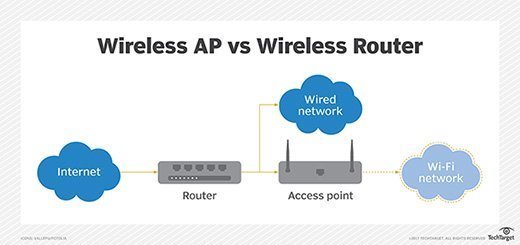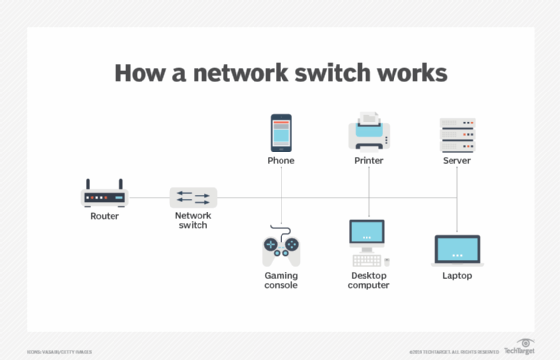
Tierney - stock.adobe.com
A glossary of home network basics for the networking novice
A remote employee's home network requires basics such as routers, modems and VPN services. For the networking novice, this glossary explains and defines these terms and more.
For businesses and employees alike, it's crucial to understand how every home network also becomes an office network amid social distancing orders and increases in remote work.
Home, or residential, networks weren't developed to support the same capacity or capabilities as office networks, which can make the transition from on-premises work to remote work difficult for newly remote employees. For employees who struggled or continue to struggle with this transition or for employees who struggle to explain their technical issues to IT teams, this glossary of home network basics can foster that technical understanding and streamline communication between groups.
The following 15 terms and phrases explore key aspects of home network basics, including the hardware required for network connectivity and different types of networks.
15 essential home network basics
Access point. If one looks up inside any business -- a Starbucks, a company headquarters, etc. -- that person is likely to see a small box installed near the ceiling, perhaps with an antenna or two; that's an AP. APs send and receive data over wireless LANs (WLANs), providing Wi-Fi clients, or devices, with Wi-Fi connectivity. APs physically connect into routers to receive wired connections they convert into wireless connectivity. APs cover larger geographic areas, which enables them to better suit larger business scenarios rather than home networks.
Bandwidth. Bandwidth is generally synonymous with capacity. If an employee has sufficient bandwidth, then that person's network connection link can support large amounts of data per second as traffic moves from the employee's device to another point on the network. Bandwidth may decrease or become less sufficient if one or more employees who work from home simultaneously are both on video conference calls.

Ethernet. Before Wi-Fi existed, Ethernet ruled network connectivity, although Ethernet is still used in modern networks. Ethernet enables network connectivity across a LAN or WAN through devices connected by a physical Ethernet cable on which data passes. Ethernet is a staple of wired network connectivity, whereas Wi-Fi is a staple of wireless network connectivity. Employees may use Ethernet to achieve more reliable network speeds or enhance network security.
Latency. Latency is generally synonymous with delay. If a network connection has low latency, the connection has a low delay time as packets -- or units of data -- travel from one network point to another. High latency means higher delay times, which lead to longer load times and buffering video or audio streams.
Local area network. LANs comprise a group of computers and devices connected in the same geographic area. A LAN could be a company's headquarters or a home network. Basic LAN equipment includes routers and switches, and either Ethernet or Wi-Fi can provide network connectivity to LANs.
Modem. A modem is a device that modulates and demodulates -- or translates -- signals that computers and other devices send and receive. Modems receive analog signals from physical network links and translate them into digital signals an internet-connected device can understand and vice versa. In home networks, modems provide connections to internet service providers, enabling internet connectivity. They also control internet connections that routers require to connect a LAN device to the internet. Also, some home networks may have a device that combines modem and router functionalities.
Networking. Computer networking enables communication and data transportation between network nodes, or different points on a network that can send or receive data. From home networks to global enterprises, networking enables endpoints and devices to communicate and share information across distances.
Remote access. Remote access is an essential part of home network basics, as remote employees require access to their corporate networks for business applications and resources. If employees have remote access -- either through a VPN or another remote access technology -- they can connect to their companies' networks from somewhere other than the company's premises. Remote access capabilities enable home networks to act as similar to corporate office networks as possible.
Router. A router acts as a gateway for networked devices to connect to the internet or to other networks, as data passes through a router to travel between one or more networks and the router directs the traffic to its destination. While a modem provides internet connectivity, a router divvies up that connectivity to connected devices and interconnects the rest of the LAN so those devices can communicate. Routers are staples of both home and office networks.
Switch. A switch operates similarly to a router, but a switch enables communication only between points on a single network, not between different networks. Switches operate in Layer 2 of the OSI model, which is the layer that controls how data moves in and out of networks. Switches are most commonly found in LANs that use Ethernet as their main source of network connectivity.

Video conference. Video conferencing connects two or more people in different locations and enables them to communicate through a camera, microphone, monitor and speakers. Although video conferencing tools can help connect geographically separated family members and friends, these capabilities are also crucial to connect remote workers to co-workers, bosses, customers and anyone else they need to communicate with for business operations.
Virtual private network. VPNs are software or hardware appliances that encrypt, or encode, connections between an authorized user's device and a corporate network and its resources. With a VPN, an employee can send and receive data as securely as if that person was in the company's office. VPNs are essential in remote access strategies and can help any home network feel more like the office.
Voice over IP. VoIP transmissions enable voice and multimedia data to travel over IP, or Internet Protocol, networks, which send data between devices over the internet. VoIP is often compared to IP telephony, which comprises technologies that also use IP connections to transmit voice, fax and other data normally transmitted over telephone networks. VoIP and telephony are also key parts of remote access to enable business operations with employees in separate locations.
Wide area network. WANs operate similarly to LANs, except a WAN connects various geographically distributed LANs together to form a larger network. For businesses, a WAN can connect a company's headquarters to different branch offices and other company facilities so all users can access company resources. A VPN can connect a remote employee to the organization's WAN.
Wi-Fi. Wi-Fi is a form of WLAN technology that operates in 802.11 standards, which are LAN protocols that control how Wi-Fi-compatible devices communicate. Wi-Fi is essential to both on-premises and remote work. Wi-Fi should be one of the first aspects employees ensure they have in their home networks.







